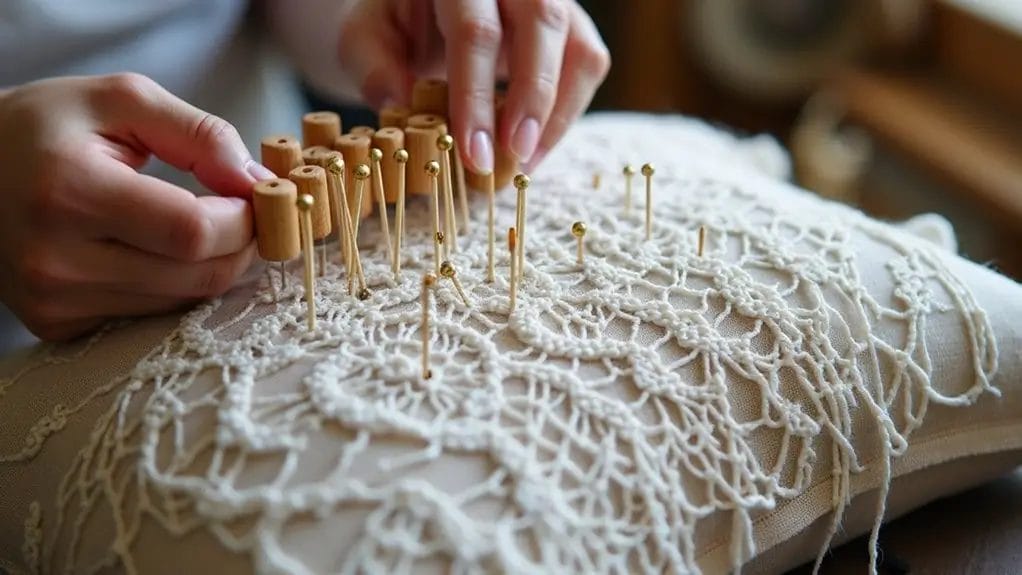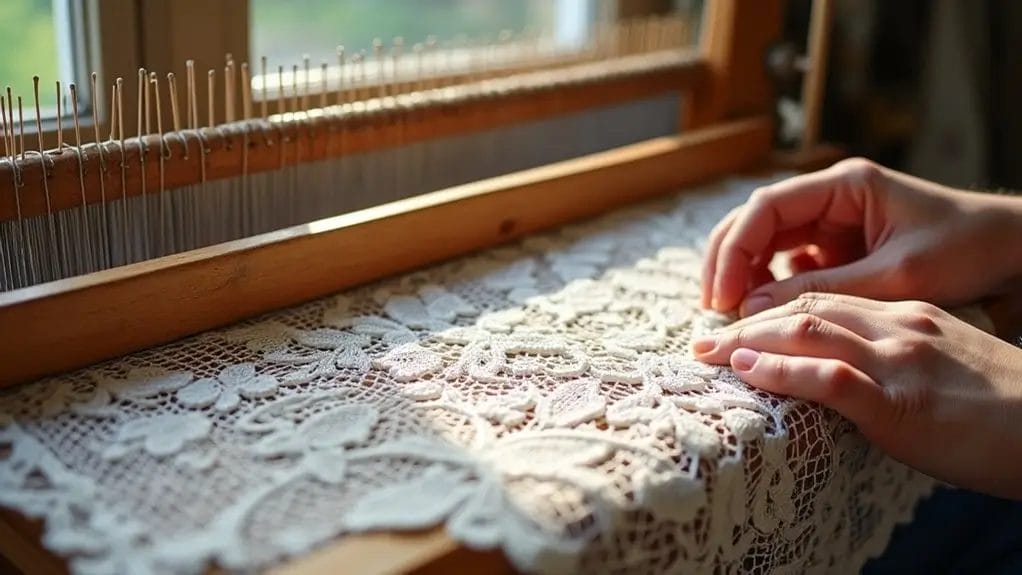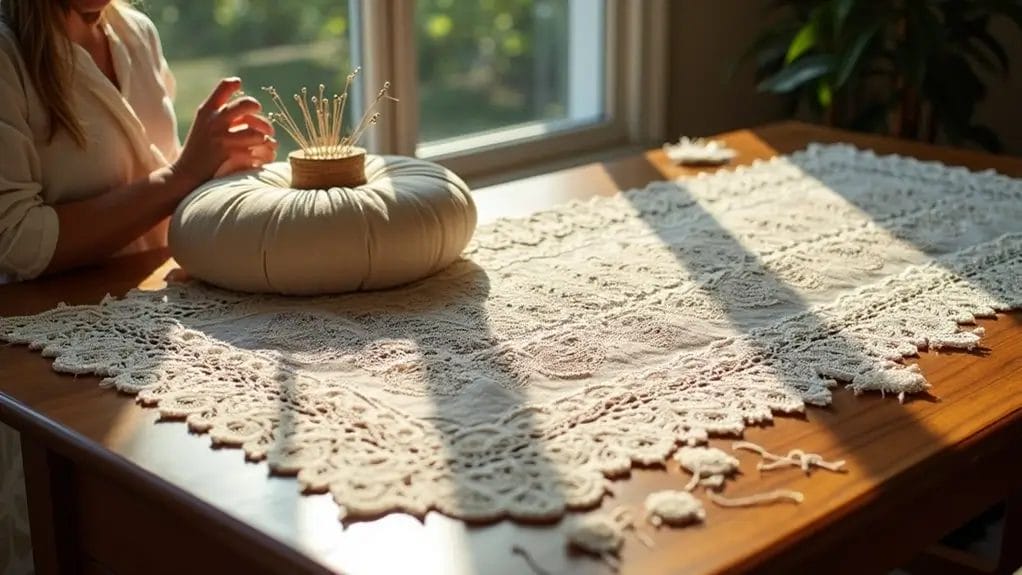You'll find that lacemaking represents one of textile art's most sophisticated achievements, combining intricate patterns with delicate craftsmanship. Whether crafted by skilled hands wielding bobbins and needles or produced on industrial machines, each piece tells a story of precision and artistic vision. From the medieval courts of Europe to today's fashion runways, lace continues to captivate with its ethereal beauty—yet the methods behind its creation remain a mystery to many.
Key Takeaways
- Lace can be created either by hand through intricate needlework and bobbin techniques, or by machines using mechanical looms.
- Hand-made lace requires extensive expertise, with craftspeople needing 3-5 years of apprenticeship to master the techniques.
- Bobbin lace involves manipulating multiple thread-wound bobbins on special pillows, while needle lace uses a single needle for detailed patterns.
- Machine-made lace production began during the Industrial Revolution, using Leavers machines to create intricate patterns more efficiently.
- Final lace creation involves washing, blocking, dyeing, and detailed finishing work like trimming excess threads and scalloping edges.
Types of Lace

When you examine lace fabric, you'll find two primary categories: painstakingly handcrafted pieces requiring years of expertise, and machine-manufactured varieties produced since the Industrial Revolution.
You'll notice that hand-made laces, such as needle lace and bobbin lace, showcase intricate patterns created through careful manipulation of individual threads, while machine-made laces can replicate these designs more quickly using mechanical looms.
The specific weaving techniques—whether it's the complex bobbin movements of Chantilly lace, the detailed needlework of Alencon, or the mechanical precision of Raschel knitted lace—determine both the final appearance and the value of the fabric.
Hand-Made Lace
The mastery of hand-made lace production represents one of textile history's most intricate and time-consuming crafts.
You'll find that creating handmade lace, including both needle and bobbin techniques, requires a 3-5 year apprenticeship, where lacemakers learn specialized techniques to produce bobbin lace and needle lace.
The process begins on a Leavers Loom, spanning 5 meters with thousands of hand-wound bobbins.
Expert tullists control the pattern creation, walking continuously on platforms to monitor the intricate stitching.
After weaving, each piece undergoes meticulous hand-dying, careful clipping of excess threads, and precise scalloping to reveal the lace's delicate pattern.
Machine-Made Lace
Modern machine-made lace emerged as a revolutionary advancement during the Industrial Revolution, offering a faster and more cost-effective alternative to traditional handcrafting methods.
The introduction of mechanical looms, particularly the Leavers machine in 1813, transformed lace production by replicating intricate bobbin lace patterns. You'll find that today's machine-made lace maintains high-quality standards while producing decorative textile pieces that decorate various items in a range of styles.
These machines use thousands of threads simultaneously, creating complex patterns through automated processes that mimic traditional techniques.
While lacking the exact character of handmade pieces, machine-made lace democratized this once-exclusive fabric for widespread use.
Different Weaves and Techniques
Diverse weaving techniques and specialized patterns distinguish various types of lace, each carrying unique characteristics that reflect their historical origins and production methods.
You'll find bobbin lace created using multiple threads wound on bobbins, while needle lace showcases intricate designs crafted solely with needle and thread.
The weave complexity varies considerably: cutwork involves precise fabric removal, tape lace utilizes sewn folded shapes, and chemical lace emerges through chemical processing.
Each lace making technique demands specific skills - from the patient precision of handmade varieties to the technical expertise required for machine-produced patterns. The result is some of the finest laces used to decorate garments and other textile items.
How is Lace Made

You'll discover that lace creation follows specific processes whether made by hand or machine, with each method requiring distinct materials ranging from traditional silk and linen to modern synthetics.
When crafting lace by hand, skilled artisans undergo years of training to master techniques like threading bobbins, operating Leavers Looms, dying, and performing intricate scalloping work.
Machine-made lace relies on sophisticated equipment like the Leavers Loom, which spans five meters and uses thousands of bobbins guided by punch cards or digital mapping to create precise patterns.
Materials Used in Lace Fabric
Traditional lace-making relies on carefully selected materials that determine both the final appearance and durability of the fabric.
You'll find that historically, linen thread and silk were the primary materials used in creating both bobbin lace and needle lace patterns. These natural fibers provided the strength and flexibility needed for intricate designs.
While silk offered luminous, embroidered effects perfect for decorative elements, linen thread proved essential for its durability and ability to hold complex patterns.
Today's lace-makers still favor these materials, though they've expanded their repertoire to include cotton and synthetic fibers for varied applications.
Steps in Creating Hand-Made Lace
Creating handmade lace requires meticulous attention to detail through a series of carefully orchestrated steps performed by highly trained artisans.
You'll find that skilled craftsmen begin by threading thousands of bobbins onto massive Leavers Looms that span five meters. These delicate patterns emerge as tullists operate the machine, constantly monitoring the intricate weaving process.
After weaving, the lace undergoes hand-dying in large vats for peak coloration.
The final steps include precise hand-clipping of excess threads and scalloping, which reveals the lace's true beauty.
Each producer of lace guarantees quality through multiple inspections, transforming simple threads into exquisite textile art.
The Machinery Behind Machine-Made Lace
While handmade lace continues to hold its prestigious place in textile artistry, machine-made lace production revolutionized the industry during the Industrial Revolution.
You'll find that modern lace fabric production primarily relies on the Leavers Loom, a massive 5-meter machine that mimics traditional bobbin lace techniques.
The process begins with weaving, where thousands of bobbins create intricate patterns guided by punch cards or digital maps.
After weaving, the lace undergoes dying in large vats to achieve desired colors. Each piece is then hand-checked for quality before moving to the scalloping phase, where excess threads are carefully removed to reveal the final design.
Techniques for Weaving Lace

When you examine traditional lace-making, you'll find that bobbin lace weaving requires intricate manipulation of multiple thread-wound bobbins on specialized pillows, while needle lace techniques involve creating detailed patterns using a single needle and thread.
Tatting produces distinctive rings and chains through a series of knots and loops using a small shuttle or needle, distinguishing it from other lace-making methods.
You'll notice that crocheted lace, though technically a form of crochet rather than true lace, creates similar openwork patterns using a single hook to interlock loops of thread in systematic sequences. These techniques can be used to create the desired lace, whether it be bobbin or needle lace, and can also incorporate elements like ribbon for added decorative flair.
Bobbin Lace Weaving
The intricate art of bobbin lace weaving requires a masterful coordination of numerous threads, each wound around wooden or bone bobbins that craftsmen manipulate to create delicate patterns.
You'll find that skilled lace makers work with up to 50 bobbins simultaneously on specialized pillows, crossing and twisting the threads in precise sequences to form decorative designs.
On a Leavers Loom spanning 5 meters, artisanal tullists thread thousands of bobbins by hand, following punch cards or digital maps to weave complex patterns.
Whether using traditional linen or modern materials, this labor-intensive process demands 3-5 years of apprenticeship to master the sophisticated weaving techniques.
Needle Lace Techniques
Master craftsmen intricately weave needle lace using a single needle and thread, creating delicate patterns through a series of precise stitches and knots.
You'll find this beautiful art requires more skill than bobbin and needle lace combined, as artisans must carefully embroider each motif without a supporting fabric base.
Unlike flaky lace that's machine-made, needle lace demands meticulous attention to detail. You're looking at a process where craftsmen work from the center outward, connecting tiny stitches to form intricate designs, often utilizing the broiderie stitch for added texture and complexity.
This technique's popularity in bridal lace stems from its exceptional durability and stunning three-dimensional effects that machine-made alternatives can't replicate.
Tatting and Crocheting Lace
Skilled artisans create tatted and crocheted lace through distinct hand-knotting techniques that emerged in the early 19th century.
While tatting originated from Flemish sailors' knot-tying methods, crochet lace developed as a faster alternative to needle lace. You'll find that tatting employs a shuttle to form rings and picots, creating delicate edgings and medallions.
Unlike traditional cutwork or needle lace fabric, crocheted lace relies on a single hook to interlock loops. The design possibilities are vast, from simple edgings to complex doilies.
Both techniques revolutionized lace-making by offering more accessible methods for creating decorative textiles.
Finishing Touches

After you've finished weaving your lace fabric, the essential processes of washing and blocking help stabilize the material and enhance its drape.
You'll need to carefully hand wash the lace in lukewarm water with gentle detergent, then block it by pinning the damp fabric to shape on a flat surface until completely dry.
If you're planning to dye your lace, you'll want to do so before the final blocking stage, using specialized fabric dyes in large vats while maintaining precise temperature control to achieve ideal color saturation and evenness.
Washing and Blocking Lace
While properly washing and blocking lace might seem intimidating, these finishing steps prove essential for maintaining the fabric's integrity and showcasing its intricate patterns.
After dying and hand inspection, your delicate lace fabric requires careful attention to preserve its refined characteristics and thread stability.
- Inspect your lace thoroughly for any loose threads or damaged areas before washing
- Use lukewarm water and gentle soap specifically designed for delicate textiles
- Never wring or twist the lace fabric while washing or drying
- Block your lace by carefully pinning it to shape on a flat surface
- Allow the lace to dry completely before removing pins to maintain its proper form
Dyeing Lace Fabric
The delicate art of dyeing lace fabric represents one of the most essential finishing stages in lace production. After careful weaving, each strip of lace fabric undergoes thorough inspection before it's prepared for the dyeing process.
Expert craftsmen hand-dye the lace in large vats to achieve ideal color saturation and quality.
Once dyed, the lace undergoes another meticulous inspection where skilled workers carefully trim connecting threads. This precision clipping reveals the intricate beauty of the pattern.
For chantilly lace pieces, artisans perform additional hand scalloping, followed by final quality checks before the lace is measured and folded for shipping.
Frequently Asked Questions
How Long Does It Take to Complete One Yard of Handmade Lace?
You'll find that creating one yard of handmade lace is incredibly time-intensive, requiring 8-10 hours of skilled labor through multiple stages including weaving, dying, and hand-clipping, following a 3-5 year apprenticeship period.
Can Damaged Antique Lace Be Repaired or Restored Successfully?
Yes, you can restore antique lace through skilled conservation techniques. You'll need a specialist who understands traditional lace-making methods, as repairs require matching original materials, reweaving damaged sections, and preserving historical authenticity.
What Special Storage Conditions Are Needed to Preserve Vintage Lace?
You'll need to store your vintage lace in acid-free tissue paper, away from light and moisture. Keep it flat in a climate-controlled environment, avoiding plastic containers, and periodically check for deterioration or pest damage.
How Can You Distinguish Between Authentic Handmade and Machine-Made Lace?
You'll notice handmade lace has slight irregularities and unique details, while machine-made lace shows perfect repetition. Examine the thread tension, knot patterns, and edges—handmade pieces display more intricate, varied craftsmanship.
Why Do Some Types of Lace Cost Significantly More Than Others?
You'll find handmade lace costs more due to the 3-5 year apprenticeship required for craftsmen, intensive labor processes, and premium materials like silk. Machine-made lace requires less skill and time, reducing the cost of lace considerably.
Conclusion
Whether you're examining handcrafted bobbin lace or machine-produced varieties, you'll find that lace-making represents centuries of refined artistic innovation. You'll appreciate how this delicate craft has evolved from time-consuming hand techniques to sophisticated mechanical processes, yet both methods demand precision and expertise. As you've discovered, the careful manipulation of threads, coupled with meticulous finishing processes, creates these enduring textile masterpieces that continue to exemplify decorative craftsmanship.


0 comments